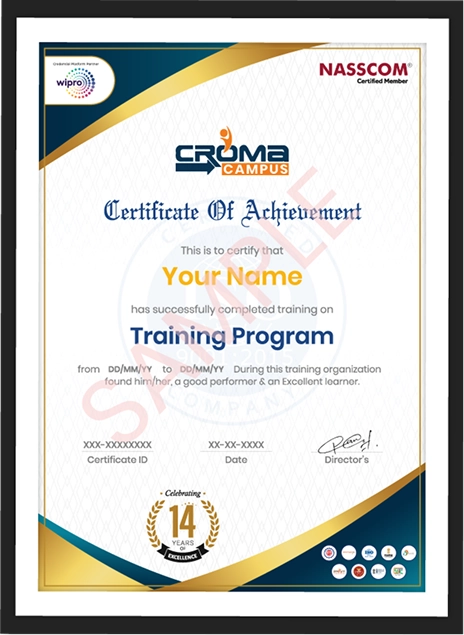Course Design By
Nasscom & Wipro
Data Proficiency: Mastering structured and unstructured data handling for various business contexts.
Informed Decision-Making: Using data effectively to make strategic decisions that drive organizational success.
Full Skill Set: Equipping students with comprehensive data science expertise, from tools and algorithms to complex data modeling, business needs analysis, and in-depth data analysis.
Broad Learning: Covering statistics, computer science, data analytics, data visualization, and programming languages like R and Python.
Advanced Concepts: Exploring big data technologies, machine learning, artificial intelligence, and deep learning.
Salary Landscape: The average salary of a data science expert stands at $139,000, as reported by Indeed.
Salary Insights: Glassdoor estimates the average salary for data science experts at $113,000.
Market Trends: According to PayScale, data science professionals earn around $100,000 on average.
Undergraduate and Postgraduate Students: Enthusiastic learners looking to kickstart a rewarding career in the field of Data Scientist Classes.
IT Professionals: Experienced IT experts looking to upgrade their skills and seize data science opportunities.
Business Professionals: Executives and decision-makers eager to enhance their data analysis capabilities.
Academics and Researchers: Scholars and researchers aiming to explore data science as an academic or research specialization.
Professionals Seeking a Career Change: Individuals from various backgrounds contemplating a transition into data science for a fresh career trajectory.
Apply Practical Knowledge: Implement acquired concepts in real-world scenarios, effectively addressing complex challenges.
Earn Certifications: Attain certifications that enhance employability and earning potential.
Secure Job Opportunities: Unlock a multitude of job openings across diverse industries and organizations.
Contribute to Industry: Play a pivotal role in the transformation of various sectors through data-driven insights and decision-making.
Obtain Leadership Positions: Possess the competence to advance into leadership roles, such as Data Science Manager, or other technical positions like Machine Learning Engineer or Data Architect.
Growing Demand: The increasing reliance on data in organizations will continue to drive demand for data professionals.
Emerging Technologies: The convergence of data science with emerging technologies like IoT, Blockchain, and AI promises diverse job roles and opportunities.
Varied Job Roles: Data science professionals will have the option to explore diverse job profiles and industries.
Evolving Data Landscape: As organizations increasingly rely on data, the field of data science will adapt to changing data landscapes.
IT Sector: Leading tech companies like IBM, Microsoft, Google, and Infosys consistently seek skilled data scientists.
Healthcare and Medical Sector: The healthcare industry relies on data for decision-making, creating a high demand for data professionals.
Banking & Finance: Financial institutions leverage data science for risk assessment, fraud detection, and customer insights.
Transportation: Data science is essential for optimizing routes, managing logistics, and improving transportation services.
Travel Industry: The travel sector employs data science for recommendations, personalization, and enhancing the customer experience.
eCommerce: Companies like Amazon, Flipkart, and Snapdeal employ data scientists to enhance user experiences and boost sales.
Media & Entertainment: Data analysis plays a pivotal role in content recommendation, user engagement, and personalization.
Non-Profit Industries: Non-profit organizations utilize data science to drive social impact and optimize operations.
Insurance Sector: Data science helps insurers analyze risks, set premiums, and predict claims effectively.
Data Science Classes: Data scientists work with complex datasets, uncovering patterns and trends to derive actionable insights. Their average salary stands at $139,000, as per Indeed, making it a highly rewarding profession.
Data Engineer: Data engineers design, construct, install, and maintain systems for data generation. Their role is pivotal in ensuring data availability and quality. They typically earn competitive salaries with growth potential.
Statistician: Statisticians play a vital role in analyzing data to generate valuable statistics, providing organizations with crucial insights. Their skills are in high demand, and they receive substantial compensation.
Business Intelligence Analyst: Business intelligence analysts focus on interpreting data to support informed decision-making in a company. Their proficiency in data-driven insights contributes to their attractive salaries.
Machine Learning Engineer: Machine learning engineers develop algorithms and models that power artificial intelligence applications. Their role is crucial in the development of AI solutions, making it a high-paying profession.
Data Science Manager: Data science managers oversee data science projects, ensuring teams work efficiently and effectively.
we train you to get hired.

By registering here, I agree to Croma Campus Terms & Conditions and Privacy Policy
+ More Lessons
Course Design By

Nasscom & Wipro
Course Offered By

Croma Campus

Stories
success
inspiration


career upgrad


career upgrad


career upgrad


career upgrad
12-Jul-2025*
07-Jul-2025*
09-Jul-2025*
12-Jul-2025*
07-Jul-2025*
09-Jul-2025*

You will get certificate after
completion of program

You will get certificate after
completion of program

You will get certificate after
completion of program
in Collaboration with






Empowering Learning Through Real Experiences and Innovation

we train you to get hired.

Phone (For Voice Call):
+91-971 152 6942WhatsApp (For Call & Chat):
+91-971 152 6942Get a peek through the entire curriculum designed that ensures Placement Guidance
Course Design By


Course Offered By

Ready to streamline Your Process? Submit Your batch request today!
Croma Campus offers comprehensive Data Scientist Course In Bangalore with expert guidance and hands-on experience, ensuring you are job-ready.
Upon course completion, you'll have proficiency in data handling, analysis, and advanced data science concepts, setting you up for a successful career.
No, there are no specific prerequisites for joining our Data Scientist Course In Bangalore. We welcome learners from various backgrounds.
Your earning potential is significant, dependent on your skill level and location.
Yes, we provide placement support to help you secure a job and kick-start your data science career.

FOR QUERIES, FEEDBACK OR ASSISTANCE
Best of support with us
For Voice Call
+91-971 152 6942For Whatsapp Call & Chat
+91-9711526942